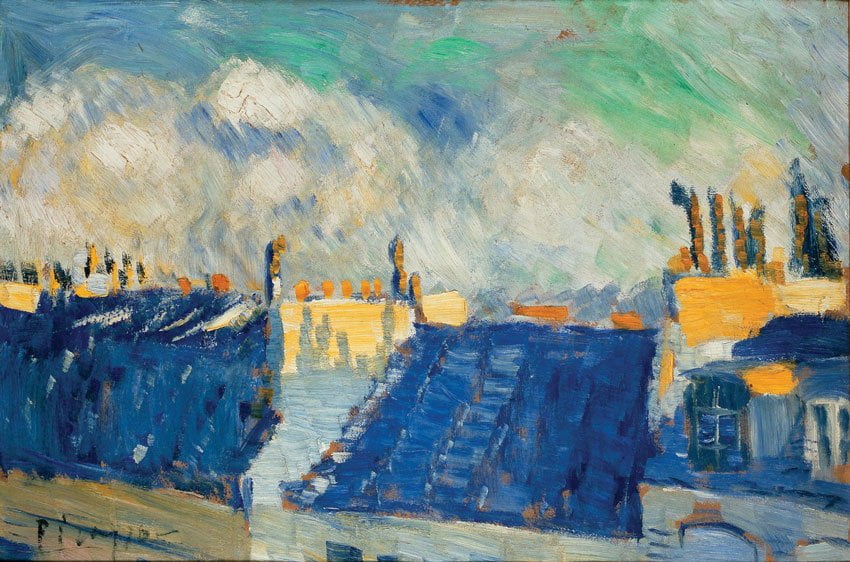The Blue Period Comes to the AGO
By DC Rutherford
An empire loses its grip on a legacy of colonialism. The credibility of the government is undermined and a coup d’état threatens from dark corners of populism. A parliamentary system is defined by polarity, as anarchism and fascism pull a nation to corners, to opposition, and apart. The proletariat confronts issues of race, gender, and the socioeconomic divide and the bourgeoisie cling desperately to the power of inequity.
The effects of systemic change, coupled with technological and ideological revolutions, impose a particular hardship on youth. A recent CDC study found that “18- to 24-year-olds reported the highest levels of symptoms of anxiety and depression” amongst all age groups. The manifestation of this depression leaves a legacy felt for generations, one that provides perspective, solace and understanding of the human condition. Nowhere is this more
apparent than in the work of our masters.

The world that surrounded Pablo Picasso at the turn of the 20th century is frighteningly similar to the one that we inhabit today. As we entered the 1900s, the struggling artist entered his 20s and began what would become known as his “Blue Period,” an artistic attempt to reconcile not just unrest in Spain and elsewhere in Europe, but the inherent struggles of burgeoning adulthood, anxiety and artistry. Picasso was troubled by mental health and the death by suicide of his friend, Carles Casagemas, the Catalan painter and poet who was the subject of several of Picasso’s works and with whom he shared a studio. The resulting work could not possibly be more engaged with our current challenges, and the Art Gallery of Ontario’s new exhibit, Picasso: Painting The Blue Period (October 6th, 2021 to January 16th, 2022) is a living monument to the beauty and catharsis that can be born of struggle.
During this time Picasso was a “young up and coming, very ambitious young man and quite cocky,” notes the AGO’s Interpretive Planner Gillian McIntyre, who worked with the gallery’s own curator Kenneth Brummel and Dr. Susan Behrends Frank of Washington, DC’s The Phillips Collection in concert with the Musée national Picasso-Paris in building the exhibit. The colliding storms of brashness and melancholy, the inspirational tempest of so many artists, brought the world such seminal pieces as “Crouching Beggarwoman,” “The Soup” and “The Blue Room,” which serve as the foundation of the exhibit. Picasso’s indulgence in blues, greens, and only a few other colours in exploring lower classes, outcasts, and the marginalized, was a reflection of how he saw himself at the time in his status and depression.

The opportunity to gather “more than 100 objects from 15 countries, including paintings, sculptures and works on paper by Picasso as well as works by artists the young Spaniard is known to have studied before and during the Blue Period” was a vivid surreal experience for McIntyre. “The curator in Washington sent me plans of the apartment and the studio he was living in and pictures; it’s just around the corner from the Moulin Rouge. And so it becomes very real.”
The legacy of such an exhibit in Toronto cannot be lost on the community. Generations of artists and audiences who get to experience Picasso: Painting The Blue Period will see Picasso’s hardship manifest in their work and their lives. The innocent engagement that children will have is nearly as priceless as the works themselves. As McIntyre recalls the divine reverie of previous visits:
“I sat them down in front of this huge painting and one of the parents was there and she said, ‘this could be a still life’ because they were so absorbed and they were all telling me what they saw. And it was wonderful, we had a great conversation, a really free, stimulating [conversation] and they literally were just – they don’t get that normally on school tours, a lot of the art teaching is quite poor or non-existent. So people wouldn’t expect kids to be able to sit in front of an abstract expressionist painting because they’re not judging, they’re not saying it doesn’t look like anything.”

McIntyre invokes essayist and novelist Pico Iyer when she imagines the lasting virtue and impression of art. “He said one of the things galleries should sell is silence – we’re not a cathedral, so you don’t have to be silent here. But for me, one of the best definitions came from a Scottish curator (I can’t remember his name now) who said galleries were where you can go to think and feel what it means to be human. And I think that is what I love about a place like this, is that you’re not being fed. It’s open, and you are invited to respond to it.”
The exhibit takes audiences through the Blue Period but ends with a glimpse of The Rose Period, Picasso’s next phase. There’s something inspired about ending on a hopeful note, assembling the manner in which the AGO wants its audience to progress through the works – perhaps an intentional way to mimic or mirror
our present realities.
“I think that’s a wonderful contemporary take on the exhibition. I don’t think that was truly the intention – it was just a sort of logical progression. It was just marvelous to be able to get all these paintings together because it’s hard to get Picassos, as you can imagine. So lovely that we were able to, and we own one from that period so we have it now nestled amongst others.”

There is something uncompromisingly uplifting about art born of sadness. It is as if artists and their ghosts can reach out from the static documents of their own engagements with struggle to comfort those of us who endure similar struggles. To walk the AGO and be surrounded by Picasso’s confrontation of society and self, discomfort and depression, is to be wrapped in the amenity of knowing. And to be so lovingly led from Blue to Rose, is to revel in the promise that this gets better, that this too shall end, that these times will soon be ghosts as well, and generations will be able to wander the graveyards of our confrontation to learn, to love, and to indeed, “feel what it means to be human.”






